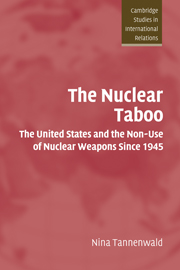Book contents
- Frontmatter
- Contents
- Preface
- List of abbreviations
- 1 Introduction: the tradition of nuclear non-use
- 2 Explaining non-use
- 3 Hiroshima and the origins of the nuclear taboo
- 4 The Korean War: the emerging taboo
- 5 The rise of the nuclear taboo, 1953–1960
- 6 Nuclear weapons and the Vietnam War
- 7 Institutionalizing the taboo, 1960–1989
- 8 The 1991 Gulf War
- 9 The taboo in the post-Cold War world
- 10 Conclusion: the prospects for the nuclear taboo
- Select bibliography
- Index
- CAMBRIDGE STUDIES IN INTERNATIONAL RELATIONS
7 - Institutionalizing the taboo, 1960–1989
Published online by Cambridge University Press: 22 September 2009
- Frontmatter
- Contents
- Preface
- List of abbreviations
- 1 Introduction: the tradition of nuclear non-use
- 2 Explaining non-use
- 3 Hiroshima and the origins of the nuclear taboo
- 4 The Korean War: the emerging taboo
- 5 The rise of the nuclear taboo, 1953–1960
- 6 Nuclear weapons and the Vietnam War
- 7 Institutionalizing the taboo, 1960–1989
- 8 The 1991 Gulf War
- 9 The taboo in the post-Cold War world
- 10 Conclusion: the prospects for the nuclear taboo
- Select bibliography
- Index
- CAMBRIDGE STUDIES IN INTERNATIONAL RELATIONS
Summary
Prevailing attitudes toward “first use” of nuclear weapons have changed considerably. The US will probably adopt a virtual “no-first-use” policy – perhaps without making a deliberate decision to do so, and perhaps without even calculating all its results.
Herman Kahn (1966)Starting in the early 1960s, the nuclear taboo, which had heretofore been tentative, began to become institutionalized in arms control agreements and internalized by US leaders. The non-use of nuclear weapons in the Vietnam War helped to further reinforce the taboo and the tradition of non-use. Use of nuclear weapons there, however, in addition to being inconsistent with American political goals in the war, would also have undercut a central US foreign policy endeavor emerging in the 1960s: the renewed and more serious efforts, especially after the 1962 Cuban missile crisis, to pursue nuclear arms control and stabilize the arms race.
As noted in Chapter 3, antinuclear-weaponism had been institutionalized in the UN disarmament machinery from an early date. Now the nuclear taboo began to become institutionalized more broadly in multilateral and bilateral arms control agreements and within the US government itself. This institutionalization was often implicit (as in the 1972 Anti-ballistic Missile Treaty, discussed below), but in some cases was quite explicit (as in nuclear non-use commitments associated with nuclear-weapons-free zones). The shift toward institutionalization was made possible by widespread acceptance by US leaders of the view that nuclear weapons should be for deterrence, not use.
- Type
- Chapter
- Information
- The Nuclear TabooThe United States and the Non-Use of Nuclear Weapons Since 1945, pp. 241 - 293Publisher: Cambridge University PressPrint publication year: 2007

